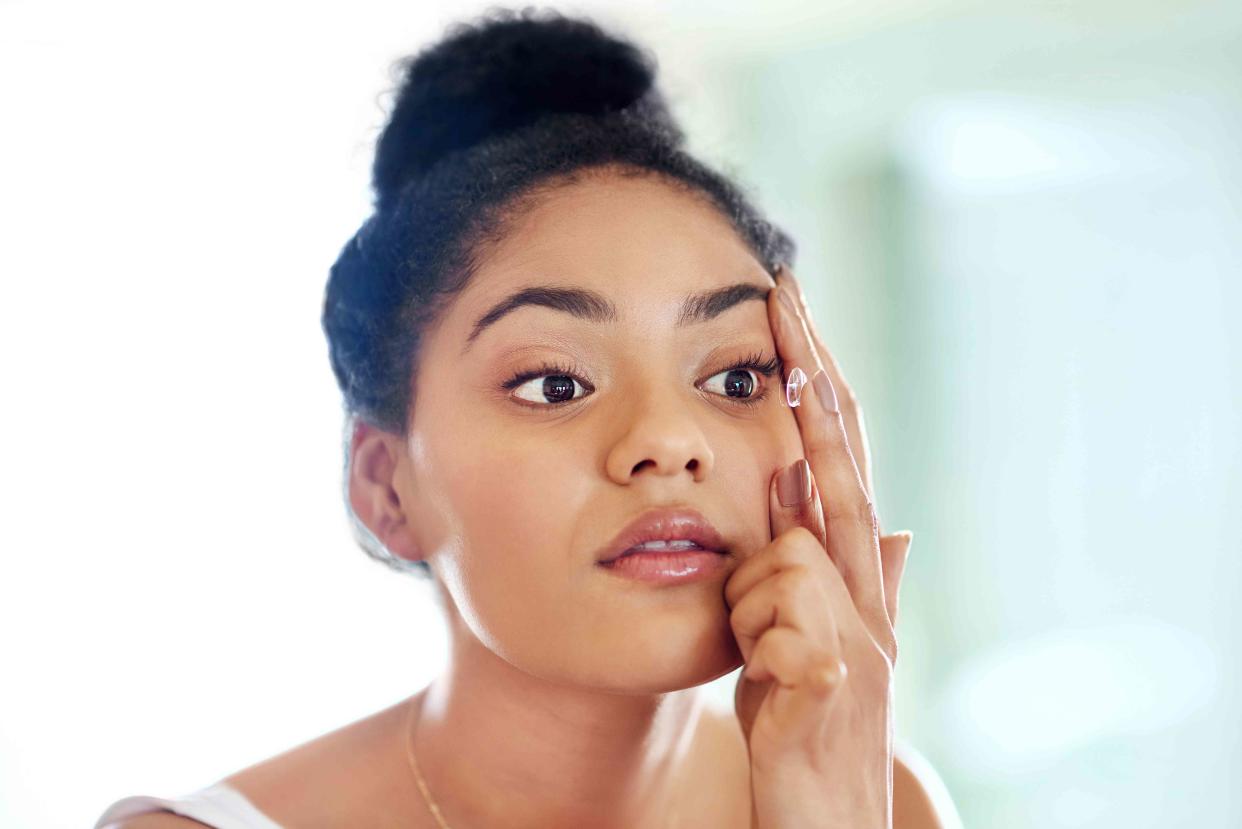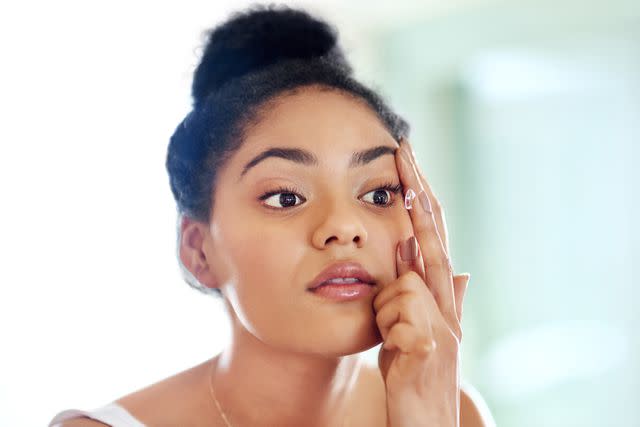What Happens To Your Body When You Sleep In Contacts?

Getty Images / PeopleImages
Fact checked by Nick Blackmer
About a third of contact lens wearers report sleeping in their contacts.
Sleeping in contact lenses, especially if done regularly, creates an optimal environment for bacteria to get into the eye area.
Experts recommend following proper contact hygiene, including properly cleaning the lenses and changing them out as instructed by a healthcare professional.
Contact lenses are worn by 45 million Americans and are considered quite safe. But caring for them improperly or keeping them in for too long—especially while you sleep—can have serious impacts on eye health, experts warn.
TV star Tori Spelling stepped out wearing a bedazzled eyepatch at the end of March to cover an ulcer on her eye, which she later revealed was caused by her frequent sleeping in contacts.
Spelling said that she’s been known to wear her daily contacts for up to 20 days, which she acknowledged was not good for her eye.
“It’s my fault, I did this to myself,” Spelling said on her 9021omg podcast. “I have contacts, but I have daily ones. And at the end of the day, whatever. I can make all the excuses I want. I don’t take them out. I sleep in them. And it’s not healthy.”
Even though the consequences can be painful, about a third of contact lens wearers say that they sleep or nap in their contacts.
“There’s not a ton of risk in wearing contact lenses,” Jordan Jones, OD, clinical instructor at the Washington University in St. Louis Department of Vision Science, told Health. “It’s typically when patients don’t follow the rules that there are some [types] of [issues] that come up.”

Getty Images / PeopleImages
The Problem With Sleeping in Contact Lenses
Since people can safely wear their contacts for long periods of time during the day, it's often assumed that sleeping in the lenses is also safe. However, experts agree that’s not the case.
Contacts sit on the cornea, which is the eye’s clear, outer layer. The cornea doesn’t have any blood vessels in it, so it needs access to oxygen in the air, explained James Reynolds, MD, professor and chair of the University at Buffalo Department of Ophthalmology Ross Eye Institute.
Contact lenses can make it more difficult for enough oxygen to get to the cornea, Dr. Reynolds told Health, which can actually lead to damage to the surface cells of the cornea, called the epithelial cells.
“When those epithelial cells suffer an injury, such as oxygen deprivation, then those cells start to deteriorate and can actually die,” he said.
These injuries happen every now and again, and in most cases, these cells repair themselves, Dr. Reynolds added. But if the cells are deprived of oxygen for too long—which can happen when someone wears their contact lenses overnight repeatedly—the problem can get worse.
“If those tears aren’t making it to the cornea easily and you’re not getting oxygen to the cornea, then the cornea can tend to break down and then be vulnerable to the bacteria that are harbored in the contact lens,” Robert Feder, MD, director of cornea service in the department of ophthalmology and professor of ophthalmology at Northwestern University Feinberg School of Medicine, told Health.
Soft contacts hang on to water, Dr. Feder explained, but can also cling on to debris or bacteria that accidentally gets in the eye throughout the day. If lenses aren’t frequently cleaned, people run the risk of getting an infection. This risk is even higher if they sleep in their contacts.
“Bacteria love it when it's warm and dark. Well, what is it when you're sleeping?" Dr. Feder said. "You're creating a situation that's warm and dark."
Sleeping in contact lenses, especially if done often, creates a perfect storm—the cornea cells are more vulnerable to bacteria, and the bacteria are given a good environment to grow and take hold. This can cause a corneal ulcer (bacterial keratitis), which is a painful defect in the cornea’s surface frequently caused by these bacterial infections.
Bacterial keratitis can be treated with aggressive antibiotics, Dr. Feder explained, but whether it causes long-term vision issues depends on the situation.
“If you have an ulcer that’s far away from the line of sight, maybe that can be treated. It’ll leave a scar but it won’t have an impact on the vision, in the way that your city sticker doesn’t really interfere with your view of the road,” Dr. Feder said. “But if that city sticker was plastered right in front of you on the windshield, it would have a major impact on your ability to drive.”
Related:Reusable Contact Lenses May Increase Risk of Rare, Sight-Threatening Eye Infection
The Best Practices for Contact Safety
Even though wearing contact lenses increases a person’s risk of eye issues, it’s not necessarily a cause for panic. The estimated annual incidence of contact lens-related bacterial keratitis is just four people out of 10,000. So, with an estimated 45 million contact lens wearers in America, that’s about 18,000 cases a year.
There are even some contacts that are FDA-approved for sleeping, though those people are still at a heightened risk of ulcers or other issues, according to Dr. Jones.
There are a number of other factors that can change a person’s risk of developing eye complications from contacts. The lenses can be tighter or looser fitting and are manufactured to be worn for different lengths of time, whether it be daily, weekly, or monthly. All of these things, as well as a person’s individual susceptibility to infection, can impact their risk of getting a corneal ulcer, Dr. Reynolds explained.
This type of corneal damage is also a “cumulative issue,” he said, which means that in general, the risk increases as a person spends more time in their contacts.
“Anytime you sleep in a contact lens, the risk goes up. Obviously, we all take naps,” Dr. Jones explained. “If you take a nap during the day in your contact lenses, it’s probably not the end of the world. It’s the overnight sleeps that [make] a big difference.”
If someone does accidentally sleep in their contacts every now and again, extensive damage is unlikely. In these situations, people should take out their contacts, add eye drops, and let their eyes rest for a bit, Dr. Feder and Dr. Reynolds agreed. Any discomfort or pain should abate within the hour, Dr. Reynolds added, though calling a healthcare professional is always an option.
As a general rule of thumb though, it’s safest to always practice good contact hygiene in order to avoid damage to the eye, experts agreed.
These hygiene practices include:
Not sleeping in contacts
Washing your hands before handling contacts
Cleaning contacts with a disinfecting solution
Replacing the contacts lens case with new contact solution, rather than topping off old contact solution
Avoiding the water to keep out germs and bacteria
Cleaning the contact lens case and replacing it every three months
“Contact lenses are great, and they’re very, very safe if you’re following the directions of whoever prescribed you the contact lenses,” Dr. Jones said. “So wear them exactly how your prescribing doctor told you to.”
Related:15 Common Causes of Blurred Vision—And What to Do About It
For more Health news, make sure to sign up for our newsletter!
Read the original article on Health.
